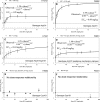Derivation of an in vivo drug exposure breakpoint for flucytosine against Candida albicans and Impact of the MIC, growth rate, and resistance genotype on the antifungal effect
- PMID: 16954320
- PMCID: PMC1635226
- DOI: 10.1128/AAC.00369-06
Derivation of an in vivo drug exposure breakpoint for flucytosine against Candida albicans and Impact of the MIC, growth rate, and resistance genotype on the antifungal effect
Abstract
Drug exposure or pharmacodynamic breakpoints refer to a magnitude of drug exposure which separates a population into groups with high and low probabilities of attaining a desired outcome. We used a pharmacodynamic model of disseminated candidiasis to define an in vivo drug exposure breakpoint for flucytosine (5FC) against Candida albicans. The results were bridged to humans by using population pharmacokinetics and Monte Carlo simulation. An in vivo drug exposure breakpoint for 5FC was apparent when serum levels were above the MIC for 45% of the dosing interval. The Monte Carlo simulations suggested that using a human dose of 100 mg/kg of body weight/day in four divided doses, 5FC resistance was defined at an MIC of 32 mg/liter. Target attainment rates following administration of 25, 50, and 100 mg/kg/day were similar, suggesting that the use of a lower dose of 5FC is possible. Using six isolates of C. albicans with MICs ranging from 0.06 to >64 mg/liter, we also explored the influence that the MIC, the fraction of the dosing interval that the serum levels of 5FC remained above the MIC (T>MIC), the 5FC resistance genotype, and the in vivo growth rate had on the response to 5FC. The MIC and T>MIC were both critical measures affecting the generation of a drug effect but had no bearing on the magnitude of the maximal kill induced by 5FC. The in vivo growth rate was a critical additional determinant of the exposure-response relationship. There was a relationship between the 5FC resistance genotype and the exposure-response relationship.
Figures







Similar articles
-
Flucytosine resistance is restricted to a single genetic clade of Candida albicans.Antimicrob Agents Chemother. 2004 Jan;48(1):262-6. doi: 10.1128/AAC.48.1.262-266.2004. Antimicrob Agents Chemother. 2004. PMID: 14693548 Free PMC article.
-
In-vitro activity of 5-fluorocytosine against 1,021 Spanish clinical isolates of Candida and other medically important yeasts.Rev Iberoam Micol. 2004 Jun;21(2):63-9. Rev Iberoam Micol. 2004. PMID: 15538829
-
In vitro activities of 5-fluorocytosine against 8,803 clinical isolates of Candida spp.: global assessment of primary resistance using National Committee for Clinical Laboratory Standards susceptibility testing methods.Antimicrob Agents Chemother. 2002 Nov;46(11):3518-21. doi: 10.1128/AAC.46.11.3518-3521.2002. Antimicrob Agents Chemother. 2002. PMID: 12384359 Free PMC article.
-
Clade-specific flucytosine resistance is due to a single nucleotide change in the FUR1 gene of Candida albicans.Antimicrob Agents Chemother. 2004 Jun;48(6):2223-7. doi: 10.1128/AAC.48.6.2223-2227.2004. Antimicrob Agents Chemother. 2004. PMID: 15155225 Free PMC article.
-
Population dynamics and the evolution of antifungal drug resistance in Candida albicans.FEMS Microbiol Lett. 2012 Aug;333(2):85-93. doi: 10.1111/j.1574-6968.2012.02587.x. Epub 2012 May 21. FEMS Microbiol Lett. 2012. PMID: 22540673 Review.
Cited by
-
A ketogenic diet enhances fluconazole efficacy in murine models of systemic fungal infection.mBio. 2024 May 8;15(5):e0064924. doi: 10.1128/mbio.00649-24. Epub 2024 Apr 15. mBio. 2024. PMID: 38619236 Free PMC article.
-
Pharmacokinetics and pharmacodynamics of a novel triazole, isavuconazole: mathematical modeling, importance of tissue concentrations, and impact of immune status on antifungal effect.Antimicrob Agents Chemother. 2009 Aug;53(8):3453-61. doi: 10.1128/AAC.01601-08. Epub 2009 May 18. Antimicrob Agents Chemother. 2009. PMID: 19451288 Free PMC article.
-
Drug Resistance and Novel Therapeutic Approaches in Invasive Candidiasis.Front Cell Infect Microbiol. 2021 Dec 14;11:759408. doi: 10.3389/fcimb.2021.759408. eCollection 2021. Front Cell Infect Microbiol. 2021. PMID: 34970504 Free PMC article. Review.
-
Therapeutic drug monitoring (TDM) of antifungal agents: guidelines from the British Society for Medical Mycology.J Antimicrob Chemother. 2014 May;69(5):1162-76. doi: 10.1093/jac/dkt508. Epub 2013 Dec 29. J Antimicrob Chemother. 2014. PMID: 24379304 Free PMC article. Review.
-
Population pharmacokinetics and CSF penetration of flucytosine in adults with HIV-associated cryptococcal meningoencephalitis.J Antimicrob Chemother. 2023 Apr 3;78(4):1015-1022. doi: 10.1093/jac/dkad038. J Antimicrob Chemother. 2023. PMID: 36857467 Free PMC article.
References
-
- Bennett, J. E., W. E. Dismukes, R. J. Duma, G. Medoff, M. A. Sande, H. Gallis, J. Leonard, B. T. Fields, M. Bradshaw, H. Haywood, Z. A. McGee, T. R. Cate, C. G. Cobbs, J. F. Warner, and D. W. Alling. 1979. A comparison of amphotericin B alone and combined with flucytosine in the treatment of cryptoccal meningitis. N. Engl. J. Med. 301:126-131. - PubMed
Publication types
MeSH terms
Substances
LinkOut - more resources
Full Text Sources

